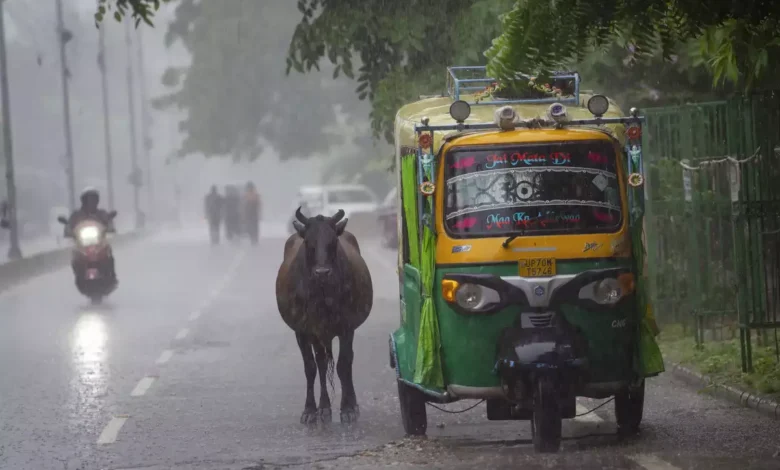Delhi Rainfall: Heaviest July rainfall in 14 years with 108 mm in 24 hours wreaks havoc
The all-time record for Delhi rainfall remains at 184 mm, recorded on July 2, 1961.

Delhi has recently experienced a historic rainfall event, marking a significant weather milestone with 108 mm of rain recorded in just 24 hours between Wednesday and Thursday. This downpour stands as the highest single-day rainfall in July in 14 years, according to data from the Safdarjung weather station. The unprecedented Delhi rainfall has brought about severe disruptions across the city, leading to the loss of 10 lives, flooding of roads, and extensive traffic congestion.
The remarkable nature of this event is underscored by its comparison to previous records. Mahesh Palawat, vice president of meteorology and climate change at Skymet, highlighted on social media platform X that the previous record for the highest 24-hour rainfall in July was set in 2010. The all-time record for Delhi rainfall remains at 184 mm, recorded on July 2, 1961. The scale of the current rainfall illustrates a significant deviation from historical patterns, reflecting the intensification of weather events.
Impact of the Delhi Rainfall
The intensity of the Delhi rainfall was particularly pronounced on Wednesday evening. Between 5:30 PM and 8:30 PM, Safdarjung recorded 79.2 mm of rain, contributing significantly to the overall total. Other areas of Delhi and the National Capital Region (NCR) also experienced substantial rainfall. Mayur Vihar recorded 119 mm, Pusa saw 66.5 mm, Delhi University registered 77.5 mm, and Palam observatory reported 43.7 mm, according to news agency PTI. The extreme weather resulted in a maximum temperature of 37.8 degrees Celsius on Wednesday.

The torrential rain caused severe flooding across the city, with numerous roads submerged under water. Visuals shared online depicted vehicles almost entirely engulfed in floodwaters, and residents struggling to navigate the city on foot amidst the relentless downpours. The heavy Delhi rainfall has led to massive traffic jams and significant disruptions to daily life, highlighting the urgent need for improved urban infrastructure and disaster management.
The effects of the rainfall have not been limited to just infrastructure damage. The sheer volume of water has overwhelmed drainage systems, exacerbating the flooding and leading to hazardous conditions for both drivers and pedestrians. Emergency services have been working tirelessly to address the immediate impacts, including rescuing stranded individuals and clearing blocked roads.
Forecast and Precautionary Measures
In response to the severe weather conditions, the India Meteorological Department (IMD) has forecasted continued heavy rainfall for Delhi and its neighboring states. The IMD’s latest bulletin predicts that the heavy rains will persist for the next five days, affecting Himachal Pradesh, Uttarakhand, Punjab, Haryana, Uttar Pradesh, and Jammu and Kashmir. This extended period of intense weather poses significant challenges for residents and authorities alike, as the region braces for further impacts.
As a precautionary measure due to the anticipated continued Delhi rainfall, schools across Delhi have been closed. Education Minister Atishi announced the closure on social media platform X late last night, reflecting the government’s commitment to safeguarding students during this extreme weather event. The severe conditions have prompted the weather department to list Delhi as an “area of concern” in the National Flash Flood Guidance Bulletin, highlighting the city’s vulnerability to such extreme weather events.
Residents have been advised to take several precautions to ensure their safety. The IMD has urged individuals to remain indoors, secure their windows and doors, and avoid unnecessary travel. These measures are essential to mitigate the risks associated with flooding and to protect residents from potential hazards posed by the ongoing heavy rainfall.
Long-Term Implications and Future Preparedness
The record-breaking Delhi rainfall has brought to the forefront the critical need for improved infrastructure and disaster preparedness. Extreme weather events like this one are becoming increasingly common due to climate change, underscoring the necessity for cities to adapt to new challenges. The intense rainfall has highlighted vulnerabilities in the city’s drainage systems and emergency response mechanisms.
As Delhi navigates the aftermath of this historic rainfall, there will likely be a renewed focus on enhancing urban infrastructure, including upgrading drainage systems and implementing better flood management strategies. Additionally, there may be increased efforts to prepare for future extreme weather events, including improved forecasting and emergency response protocols.
In conclusion, the recent Delhi rainfall event serves as a stark reminder of the growing impact of climate change and the urgent need for cities to bolster their resilience against extreme weather. The combination of historical rainfall records and current impacts underscores the importance of proactive measures to protect lives and infrastructure in an era of increasing weather volatility.
You might also be interested in: Wayanad launches India’s first rain gauge website for weather monitoring



